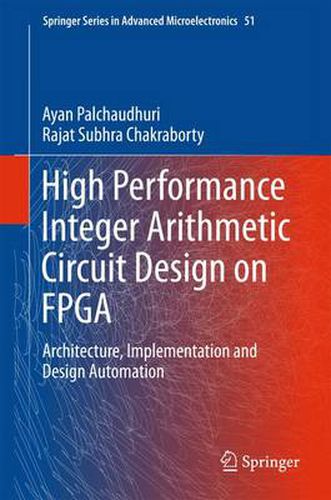Readings Newsletter
Become a Readings Member to make your shopping experience even easier.
Sign in or sign up for free!
You’re not far away from qualifying for FREE standard shipping within Australia
You’ve qualified for FREE standard shipping within Australia
The cart is loading…






This title is printed to order. This book may have been self-published. If so, we cannot guarantee the quality of the content. In the main most books will have gone through the editing process however some may not. We therefore suggest that you be aware of this before ordering this book. If in doubt check either the author or publisher’s details as we are unable to accept any returns unless they are faulty. Please contact us if you have any questions.
This book describes the optimized implementations of several arithmetic datapath, controlpath and pseudorandom sequence generator circuits for realization of high performance arithmetic circuits targeted towards a specific family of the high-end Field Programmable Gate Arrays (FPGAs). It explores regular, modular, cascadable and bit-sliced architectures of these circuits, by directly instantiating the target FPGA-specific primitives in the HDL. Every proposed architecture is justified with detailed mathematical analyses. Simultaneously, constrained placement of the circuit building blocks is performed, by placing the logically related hardware primitives in close proximity to one another by supplying relevant placement constraints in the Xilinx proprietary User Constraints File . The book covers the implementation of a GUI-based CAD tool named FlexiCore integrated with the Xilinx Integrated Software Environment (ISE) for design automation of platform-specific high-performance arithmetic circuits from user-level specifications. This tool has been used to implement the proposed circuits, as well as hardware implementations of integer arithmetic algorithms where several of the proposed circuits are used as building blocks. Implementation results demonstrate higher performance and superior operand-width scalability for the proposed circuits, with respect to implementations derived through other existing approaches. This book will prove useful to researchers, students and professionals engaged in the domain of FPGA circuit optimization and implementation.
$9.00 standard shipping within Australia
FREE standard shipping within Australia for orders over $100.00
Express & International shipping calculated at checkout
This title is printed to order. This book may have been self-published. If so, we cannot guarantee the quality of the content. In the main most books will have gone through the editing process however some may not. We therefore suggest that you be aware of this before ordering this book. If in doubt check either the author or publisher’s details as we are unable to accept any returns unless they are faulty. Please contact us if you have any questions.
This book describes the optimized implementations of several arithmetic datapath, controlpath and pseudorandom sequence generator circuits for realization of high performance arithmetic circuits targeted towards a specific family of the high-end Field Programmable Gate Arrays (FPGAs). It explores regular, modular, cascadable and bit-sliced architectures of these circuits, by directly instantiating the target FPGA-specific primitives in the HDL. Every proposed architecture is justified with detailed mathematical analyses. Simultaneously, constrained placement of the circuit building blocks is performed, by placing the logically related hardware primitives in close proximity to one another by supplying relevant placement constraints in the Xilinx proprietary User Constraints File . The book covers the implementation of a GUI-based CAD tool named FlexiCore integrated with the Xilinx Integrated Software Environment (ISE) for design automation of platform-specific high-performance arithmetic circuits from user-level specifications. This tool has been used to implement the proposed circuits, as well as hardware implementations of integer arithmetic algorithms where several of the proposed circuits are used as building blocks. Implementation results demonstrate higher performance and superior operand-width scalability for the proposed circuits, with respect to implementations derived through other existing approaches. This book will prove useful to researchers, students and professionals engaged in the domain of FPGA circuit optimization and implementation.